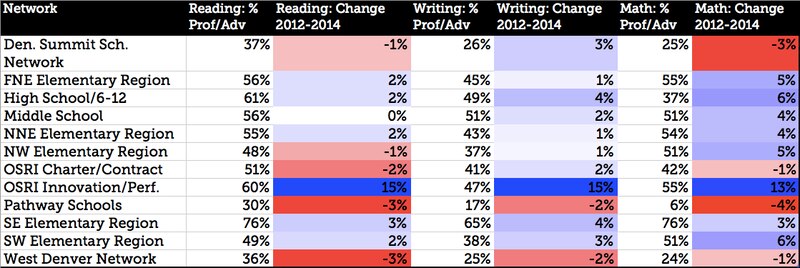In the final year of the current state testing regimen, Denver Public Schools made steady but incremental gains in key areas but over half of Denver students are still not reaching grade level targets.
“To be at grade level is a strong and sometimes painfully strong, predictor of whether you’ll graduate high school,” said Denver superintendent Tom Boasberg. He said the lack of progress for the state as a whole, especially for low-income students, was “a crisis.” Read our story on the state-level results here.
Denver students’ test scores rose just over two percentage points in math and just over three percentage points in writing. Scores in writing remained largely stagnant and reading scores in the earliest tested grades, which was a focus for the district as a law focused on early literacy goes into effect, dropped slightly.
“[Early literacy] is such a critical indicator,” said Boasberg. He pointed to expanding preschool — an idea which will go before voters this fall— as a necessary step to improve the district’s early reading scores.

Boasberg also acknowledged voices that say the pace of improvement in the district is too slow.
“I’m one of those voices,” Boasberg said. But, he said, “there’s no secret sauce.”
[Search Chalkbeat Colorado’s database for 2014 results by district, school, grade and subject.]
Chalkbeat spoke with Boasberg and dug through Denver’s scores to pull a few highlights from this year’s data dump. Read on for a few takeaways and return in the next days, as we dig into the district’s scores — and look at what, if anything, we can learn from them.
Ex-principals and their test scores
Last school year was marked by a series of high profile leadership changes at several of the district’s lowest performing schools, including a mid-year change at Manual High School. When parents and community members objected to leadership changes, district officials often cited insufficient progress or low scores as a factor in the principal’s removal. But this year’s results suggest that it may not be that simple.
At Manual, students made single-digit gains in all areas, although the school failed to reach its 2012 levels in reading. This year, 29 percent of students were proficient in reading, 16 percent of students were proficient in writing and just six percent of students were proficient in math.
Columbine Elementary, whose principal Beth Yates was replaced at the end of the year, saw an increase in students working at grade level across content areas. Columbine, in particular, saw double-digit gains in reading and writing under Yates. Her successor, Jason Krause, came from Smith Renaissance School, another Northeast Denver elementary school that has seen steady gains.
Boasberg would not comment on individual personnel decisions.

One bright(ish) spot: the city’s middle schools
Historically an area of weakness, Denver’s middle schools have seen steady if slow gains in reading and writing over the past three years. And nearly a third of the city’s middle schools scored high enough on the state’s measure of student progress to be called “high growth.”
“Our middle schools are some of the best middle schools in the state,” Boasberg told Chalkbeat.
What percent of Denver middle schoolers are working at grade-level? | Create Infographics[Mouse over the figure to see more details]
Still, much of those gains came from the city’s charter schools; the district-run schools grew slightly in writing but have declined in both reading and math since 2012. At Kepner Middle School in southwest Denver, where district officials announced a planned overhaul for the 2015-16 school year, scores declined or stagnated in all subjects. Charter schools have grown consistently in reading and writing but saw their scores decline in math this year. The average proficiency level in charters remains nearly 10 points higher than district-run middle schools.
For example, KIPP Montbello, which serves a predominantly low-income student population, has seen an 18 percentage point gain in reading proficiency since 2012. One of KIPP’s other campuses, Sunshine Peak Academy in southwest Denver, saw a nine point jump in reading proficiency in the same time period. Some district-run schools saw similar gains, such as a 10 point jump in the number of students writing proficiently at Stapleton’s McAuliffe International School.
And not all was well with the district’s charter schools. The STRIVE network, which is one of the largest and historically highest performing charter networks in the city, saw declines in most subjects at nearly all its middle schools. At its original Federal campus, the number of students who scored proficient in math dropped by 17 percentage point and scores in reading and writing dropped by five and eight percentage points respectively. The Lake campus saw similar declines, although the dropoff in writing was not as precipitous. STRIVE is slated to be a part of the Kepner turnaround process. Chalkbeat will be digging into STRIVE’s decline and the performance of the city’s charter networks later this week.
Mixed performance among school networks
One of the district’s key strategies for its lowest performing schools has been to organize them into networks, like the systems of schools in west and far northeast Denver. Schools in the networks receive targeted support from the district and often use similar strategies to try and improve student outcomes.
For example, schools in the Far Northeast network, which is known as the Denver Summit School Network, have longer days and years. They also participate in a small-group math tutoring program. Some other networks are based solely on geography (for example, the district’s elementary networks) or school type (like charter or innovation).

Find out which network your school is in here.
This year’s results show that the network strategy has produced mixed results. The Far Northeast turnaround network and the West Denver Network, which is also targeted at struggling schools, both saw declines in multiple subject areas. Charter schools saw a slight decline in performance in both reading and math, and overall performance remained slightly below the district average. And the district’s alternative pathways schools, which serve students who are at risk or have already dropped out of school, saw their already low levels of proficiency decline further.
One exception to the overall declines in the district’s targeted initiatives is the district’s innovation schools, which have increased across all subjects.
For example, the percent of students at Valdez Elementary reading and writing proficiently increased by double-digits and the school saw a small increase in math as well. Innovation schools receive increased freedom from state and district requirements, under a 2008 law.
Note that over half the district’s innovation schools are in that network. Manual High School, for example, was moved into the high school network after its low performance came to light earlier this year. Others are in the Pathways Schools network or one of the district’s two turnaround networks.
Send us your DPS TCAP questions. We’ll take the best questions and answer them in a followup post. You can find us at tips@co.chalkbeat.org or on Twitter @chalkbeatCO.

